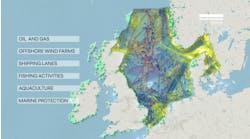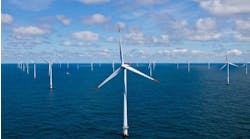Report calls for action to sustain UK North Sea production
Offshore staff
LONDON – Britain could be importing most of its oil and gas supplies by 2030 without fresh investment in its North Sea fields, according to a report by Offshore Energies UK (OEUK).
The 2022 Business Outlook report shows that around 80% of UK gas supplies and more than 70% of its oil would have to be sourced abroad without new action.
And although studies suggest that the UK has sufficient proven reserves to support production for at least 15 years, there has been insufficient investment in the platforms, pipelines and other infrastructure needed to develop the resources, OEUK claims.
The contribution from Britain’s offshore wind farms remains too small at present to replace the declines in oil and gas output from the North Sea.
“Production of oil and gas will fall by up to 15% a year unless there is rapid investment in new infrastructure,” the report said. “This decline is much faster than the predicted reduction in UK energy demand.”
The research, led by OEUK’s market intelligence manager Ross Dornan, provides further insights:
- Norwegian gas imports now exceed UK supplies, with 32 bcm of the 76 bcm consumed coming from Norway, and 29 bcm from the UK continental shelf
- Gas and oil supplied 75% of the UK’s total energy in 2021, 2% more than in 2020.
- Gas remains the UK’s largest energy source, accounting for 43% of its total energy last year.
- Oil is the second largest energy source at 32%
- The UK’s oil and gas production dipped sharply in 2021, to 45 MM metric tons and 29 bcm respectively – 17% down on the total for 2020
- Imports surged in 2021, accounting for 62% of the UK’s gas needs and 18% of its oil.
Investment in Britain’s oil and gas sector looks set to fall to £4 billion ($5.24 billion) this year, compared with around £16 billion ($20.95 billion) in 2014. Contributory factors are said to include the UK’s complex regulatory environment, political issues concerning climate change and mooted windfall taxes, all of which have been deterring investment.
Offshore wind also requires significant investment for expansion to continue. The report suggests the UK will need to spend £60 billion ($78.6 billion) in 3,000 new offshore wind turbines to meet its target of quadrupling wind-powered electricity generation by 2030.
Ross Dornan said: “The energy gap between what we produce ourselves and that which comes from other nations will keep growing unless we invest in exploration and production on the UK’s continental shelf. We must also accelerate the development of cleaner energy like hydrogen…Additionally, the emissions generated by processing and transporting our own oil and gas are much lower than for imports.”
Deirdre Michie, chief executive of OEUK, added: “Last year OEUK signed the North Sea Transition Deal, a partnership with the UK government supporting the nation’s transition to a lower-carbon future and providing safe and secure energy throughout that transition. But that transition will only happen if our policymakers can create and sustain the right environment for long-term investment across all forms of energy production. To achieve that we need stable long-term regulatory policies, clear and predictable fiscal policies and improved political alignment across all the countries and parties of the UK. Energy security is now a matter of national security. Our policymakers need to plan not just for the coming elections but the coming decades.”
3/31/2022



